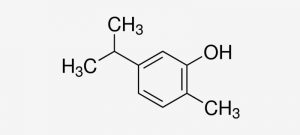Carvacrol Antioxidants and Flavoring Ingredients in Food
Carvacrol, known scientifically as 5-isopropyl-2-methylphenol or isothymol, presents as a colorless to yellowish liquid distinguished by its pungent aroma, akin to that of thymol. This monoterpenoid phenolic compound is predominantly found in the essential oils of the Lamiaceae family, including oregano, thyme, and winter mint. It is produced through the sulphonation of cymene.

Noteworthy for carvacrol’s multifaceted biological properties, carvacrol boasts anti-inflammatory, antioxidant, and antibacterial effects. Its potent ability to eliminate bacteria and intestinal parasites has led to its use as a disinfectant and fungicide. Beyond these applications, carvacrol is extensively utilized across various domains such as in spices, food additives, feed additives, antioxidants, and as pharmaceutical intermediates. This paper aims to explore the significance of antioxidants and flavoring agents in food, underlining the pivotal role of compounds like carvacrol.
Exploring the Chemical Nature of Carvacrol
The Structure at a Molecular Level
At its core, Carvacrol, or 5-isopropyl-2-methylphenol, unveils a molecular structure brimming with complexity, underpinning its distinct characteristics. The presence of a phenol group, enriched with isopropyl and methyl substitutes, categorizes it as a monoterpenoid phenolic compound. This unique molecular arrangement plays a pivotal role in its biological efficacy and its dissolvability across various solvents.
Distinguishing Physical Traits
Manifesting as a colorless to a mildly yellow viscous fluid under ambient conditions, Carvacrol exudes a robust, thyme-like scent. Its solubility profile shows a minor affinity towards water while demonstrating significant solubility in organic solvents such as ethanol, methanol, and ether. The compound’s boiling point, which sits between 237°C to 238°C, speaks to its resilience at elevated temperatures.
Carvacrol’s Natural Reserves
Predominantly sourced from the essential oils of Lamiaceae family herbs—oregano (Origanum vulgare), thyme (Thymus vulgaris), and peppermint (Mentha piperita)—Carvacrol’s synthesis journey begins with the sulphonation of cymene. The Mediterranean basin, rich in these botanical species, serves as a bountiful reservoir of Carvacrol.
Unveiling Carvacrol’s Antioxidant Virtues
The Antioxidant Mechanism
The secret to Carvacrol’s antioxidant prowess lies in its capacity to donate hydrogen atoms or electrons, counteracting the free radicals responsible for cellular oxidative stress. Such defensive action is crucial for safeguarding cell membranes, DNA, and other intracellular structures against oxidative harm, thus thwarting the progression of chronic conditions.
Empirical Evidence of Antioxidant Potency
A wealth of scientific inquiries has thrown light on Carvacrol’s formidable antioxidant strength. Studies demonstrate its potential to markedly curb lipid peroxidation while boosting cellular antioxidant enzyme functions, rivaling synthetic antioxidants in free radical scavenging efficiency and emerging as a superior natural alternative.
Preserving Food Quality
Leveraging its antioxidant properties, Carvacrol finds extensive application within the food sector as a natural preservative. It notably prolongs the shelf life of various food items by inhibiting fat and oil oxidation, thereby preserving food safety and quality. Its utility is especially noteworthy in meat, dairy, and processed food conservation.

Carvacrol as a Flavoring Essence
Flavor and Aroma Profile
Carvacrol is celebrated for its distinctly warm, thyme-mimicking aroma, paired with a subtly spicy, cooling palate impression, rendering it a coveted culinary flavor enhancer. Its unique sensory qualities contribute significantly to the flavor dynamics of food items.
Flavor Synergism
Carvacrol stands out for its ability to amplify food flavors through synergistic interactions with other flavoring agents, enriching the food’s taste complexity. This attribute is conspicuously beneficial in the formulation of spice mixes and herbal condiments, where it enhances overall flavor harmony.
A Spectrum of Culinary Uses
The gastronomic applications of Carvacrol are extensive and varied. It is a staple in Mediterranean culinary practices, infusing Greek and Italian specialties with its characteristic flavors. Its usage spans from flavoring pizzas and pasta sauces with oregano oil to enriching marinades, dressings, and even baked goods. Carvacrol’s foray into beverages and sweets further underscores its versatility and appeal as a flavor-enhancing agent.
The Multifaceted Health Advantages of Carvacrol
Antimicrobial Strength
Carvacrol stands out for its exceptional antimicrobial capabilities, creating a robust shield against a vast array of microorganisms, such as bacteria, fungi, and viruses. This compound effectively breaches the cell walls of these pathogens, leading to their destruction. Its prowess in fighting off infections positions it as a key component in hygiene products and underscores its potential for treating various microbial infections, enhancing both environmental and personal health safety.
Anti-inflammatory Properties
Carvacrol’s benefits extend to impressive anti-inflammatory properties. By curtailing the production of pro-inflammatory cytokines, it significantly reduces inflammation and eases pain linked to numerous conditions, including arthritis and chronic inflammatory diseases. Originating from nature, carvacrol emerges as a compelling, side-effect-free alternative to traditional anti-inflammatory medications, offering a path to relief rooted in the natural world.
Therapeutic Potential
Studies have shown its effectiveness in supporting respiratory health, and easing symptoms of asthma and bronchitis. Its antioxidant abilities also act as a shield against certain cancers by counteracting free radicals and slowing the growth of cancer cells. Moreover, emerging research suggests carvacrol’s potential for neuroprotection, indicating its capacity to aid in the prevention and treatment of neurodegenerative conditions. These varied therapeutic applications underscore carvacrol’s role as a versatile and promising agent in contemporary healthcare.
UniVOOK Chemical’s Mastery of Carvacrol – Purity Meets Versatility
Bridging Nature and Innovation for Diverse Applications
UniVOOK Chemical Company stands at the forefront of chemical innovation, meticulously crafting high-purity 5-isopropyl-2-methylphenol, commonly known as carvacrol, through cutting-edge chemical processes. Our synthetic carvacrol is designed to perfectly mimic its natural counterpart, facilitating its effortless incorporation into a myriad of applications. Moving beyond its traditional role as a food and feed preservative, our carvacrol finds new applications in chemical synthesis, household cleaning products, cosmetics, personal care, pharmaceuticals, and as an effective fungicide in the agricultural sector.
The Distinguished Features of Carvacrol
UniVOOK Chemical’s commitment to excellence ensures that our carvacrol stands out with unmatched purity, significantly enhancing the caliber of your products. Celebrated for its powerful antibacterial properties, our carvacrol has become a cornerstone in diverse industries, from food preservation to pharmaceutical applications. It imbues products with its distinctive scent, introducing a hint of natural sophistication to culinary dishes, personal care products, and aromatherapy practices. The application range of our 5-isopropyl-2-methylphenol is vast, capable of augmenting the taste of foods and beverages, as well as adding an aromatic allure to cosmetic products. Beyond its sensory impact, carvacrol is recognized for its health-promoting benefits, including anti-inflammatory and antioxidant properties, enhancing wellness-oriented product formulations in both cosmetics and healthcare. Moreover, UniVOOK Chemical’s unwavering commitment to transparency ensures complete traceability of our carvacrol, solidifying client confidence in the purity and origin of our high-quality ingredients.
Final Thoughts
Carvacrol stands as a remarkable compound, weaving its antioxidative and flavor-enhancing properties seamlessly into the food industry. Its robust antimicrobial and anti-inflammatory capabilities not only promise enhanced food safety and preservation but also offer potential health benefits, making it an invaluable ingredient in culinary and medicinal applications. The distinct aroma and flavor profile of carvacrol enriches food products, adding depth and natural elegance. As research continues to unveil its therapeutic potential, carvacrol’s role in food science and health sectors is set to grow, highlighting its significance as a versatile and beneficial compound.
Access Our Product Catalog and More to Discover High-Performance Chemicals Tailored to Your Business Needs




